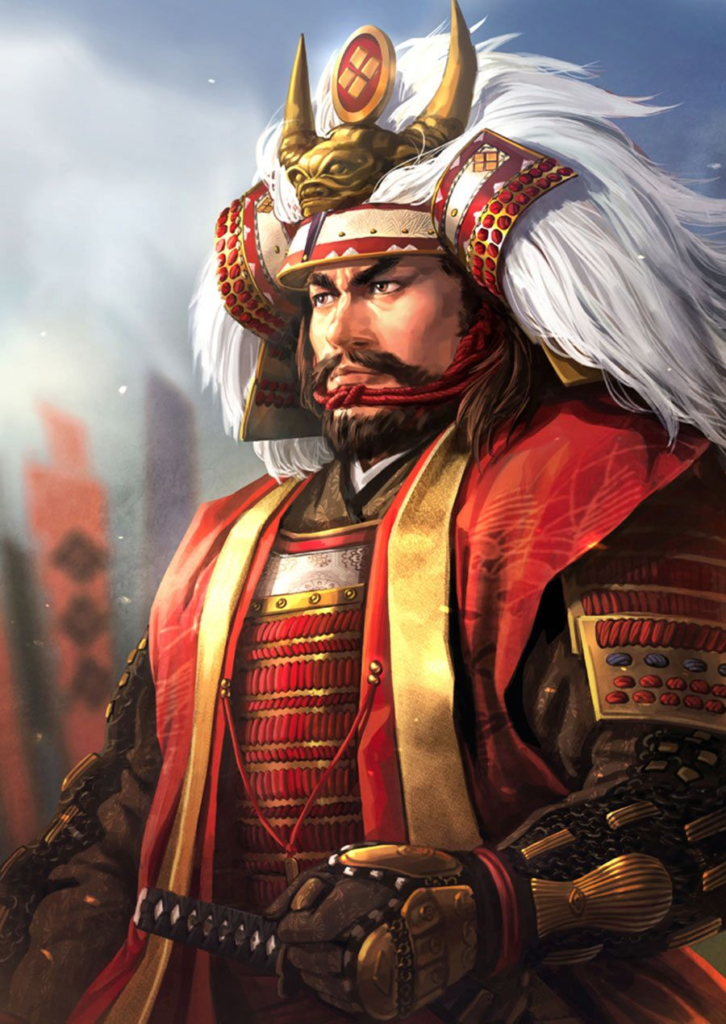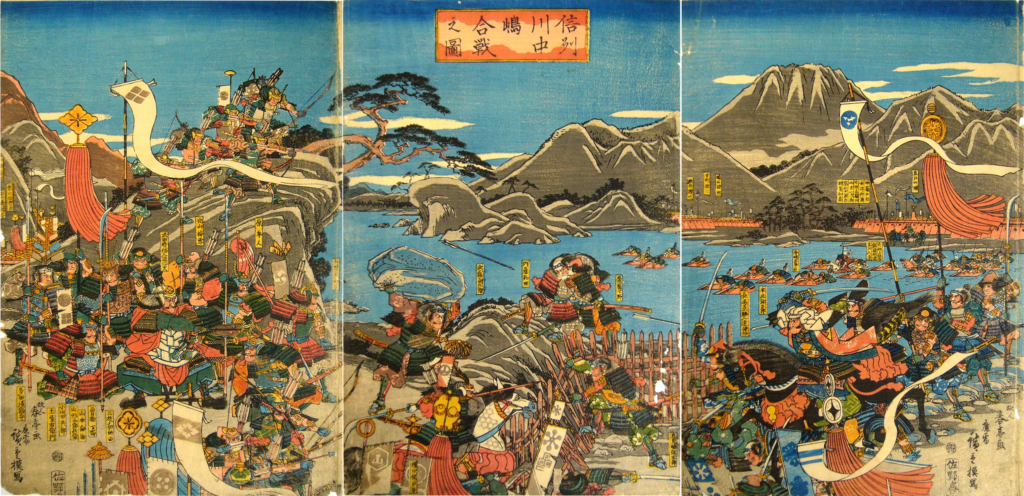By: AJ Witte
If there is anything that I enjoy more than anything in the world it would be video games. Among the vast genres of video games that have piqued my interest, history based strategy games are definitely among them. Total War: Shogun 2 is a real-time strategy game which focuses on the onin war, or the period of time where Japan was thrown into a time of great strife and war. The goal of the game is to take control of the daimyo of one of these warring clans, and rise to the rank of shogun, gaining military control over all of Japan. One of my personal favorites being Takeda Shingen, the daimyo of the Takeda clan. Takeda Shingen was born in Kai province in December 1, 1521 as the eldest son of Takeda Nobutora, the then head of the Takeda clan under the shugo daimyo (Pletcher). His father was known to be rather cruel and so Shingen lead a very difficult and cold childhood. Shingen would eventually take control of the Takeda clan in 1541 where he forced his father into abdication. After assuming control Shingen would expand his clan northward into what Shinano province and various lands adjacent to his home province of Kai. An interesting note is that Takeda Shingen was not born under the name of Takeda Shingen. His birth name was Takeda Harunobu, until his eventual entry into the buddhist priesthood where he adopted the name of Shingen (Pletcher). Takeda Shingen is most notable for his lengthy history with the Uesugi clan over the Kanto region of Japan. He was even known to rival the great Oda Nobunaga who would eventually work to unify Japan under one banner as well as Nobunaga’s close ally Tokugawa Ieyasu (Wikipedia). However, his rivalry with the Uesugi is where Takeda Shingen would achieve his eventual status as one of the greatest generals Japan has ever known.

Artists rendition of Takeda Shingen
One of the most famous battles between the two clans was the Battle of Kawanakajima, a series of five battles which were fought over control of the aforementioned Kawanakajima region, which was a key transportation route between the north and south of Japan. These battles were sparked after Takeda Shingen conquered the Shimano province, subsequently expelling Ogasawara Nagatoki and Murakami Yoshikiyo, two daimyos who turned to Uesugi Kenshin for assistance (Wikipedia).
The first battle, known as the “battle of Fuse” was originally fought in 1553 and was a smaller scale skirmish fought at the shrine of Hachiman. Takeda after capturing Katsura Castle and by extension forcing out Murakami Yoshikiyo would begin his march into Kawanakajima. This push extended along the eastern bank of the Chikumagawa River. Uesugi Kenshin would march the opposite side, the western bank in support of his ally Yoshikiyo, where the two armies would meet each other at the aforementioned Shrine of Hachiman. Takeda Shingen would lose this skirmish and eventually withdraw his forces. After this initial loss Takeda Shingen would return in September to finish off the Murakami Yoshikiyo where he was chased off again by the supporting forces of Uesugi Kenshin. Both forces were forced to disengage due to the eventual coming of the winter (Wikipedia).
The second battle, known as the battle of Saigawa raged from August to November of 1555. Takeda Shingen would return to Kawanakajima this time advancing up the Sai River. He would eventually set his camp on a hill to the south of the Sai river. Uesugi Kenshin would camp his forces to the east of the Kenko-Ji temple which provided a far superior view of the plain and by extension the Takeda forces. Takeda was not alone in this battle as his close allies, the Kurita clan would rival Uesugi’s right flank as they held Asahiyama fortress, a castle which lay a few kilometers to the west of the Uesugi’s forces. Uesugi would try many times to kick out said Kurita reinforcements but failed to take the castle. This would result in the eventual push by Uesugi to attack the main Takeda force. The attack would fail to come however, as both forces sat idle for months with the battle never coming. Both Uesugi Kenshin and Takeda Shingen were forced to return to their home province due to domestic matters (Wikipedia). This peace was mediated by one Imagawa Yoshimoto, one of the three daimyos of the Tokaido region (Wikipedia).
The third, which is formally known as “The Battle of Ueonohara”, took place in 1557. Takeda Shingen would capture the fortress Katsurayama which overlooked the Zenko-ji temple. Takeda Shingen would then push his luck as he attempts to castle Liyama. This attack would prove fruitless as Uesugi Kenshin with his soldiers still stationed in Zenko-ji temple would repel Shingen’s attack (Wikipedia).
The fourth battle would be known for its great bloodshed, as it was the bloodiest battle by percentage of total forces in the entire Sengoku period. After besieging Hojo Ujiyasu’s Odawara castle, Uesugi Kenshin would leave his Kasugayama castle with 13,000 warriors to finally destroy Takeda Shingen once and for all. Shingen on the other hand would leave Kofu with 16,000 men while acquiring around 4,000 more as he traveled through his Shimano province. The main battle would be pitched at the Chikumagawa River. Both armies wished to maintain the element of surprise and as such, patiently awaited the other’s movement. Eventually, Uesugi Kenshin would correctly guess Shingen’s plan and would march his army down the mountain into the now infamous Kawanakajima plain, catching Shingen’s force off guard. The Uesugi would attack in waves, with the bulk of his army helmed by generals Kakizaki Kageie, and Irobe Katsunaga (Wikipedia). Two prominent generals during the Sengoku period. Shingen’s commanders would eventually fall one by one to the constant onslaught of Kenshin’s army until Uesugi himself would reach Takeda’s command post. This would be the beginning of one of the most famous instances of single combat in Japanese history as Takeda Shingen would fight Uesugi in a duel. Takeda Shingen would famously parry Kenshin’s killing blow with his signaling fan. Shingen would be able to hold off Uesugi long enough so that one of Shingen’s retainers could spear Kenshin’s mount, causing him to retreat (Wikipedia). Shingen’s forces despite being weathered down by Uesugi’s forces would eventually emerge victorious.
The fifth and final battle would take place in September 1564, where Uesugi Kenshin and Takeda Shingen would clash for the fifth and final time in the bloodsoaked plain of Kawanakajima. Despite being the final battle, this would in no way compare to the fourth battle, as they would skirmish for around 60 days, until they would both withdraw their forces (Wikipedia).

A woodblock painting of the battle of KawanakaJima
These battles would mark a prime example of what marked the Sengoku period as one of the most bloody as well as fascinating times in Japanese History, clan warfare such as the rivalry between Uesugi Kenshin and Takeda Shingen. Takeda Shingen would eventually die to unknown causes in his camp at Kobama in Shinano on May 13, 1573, where he was succeeded by his fourth son, Takeda Katsuyori (Pletcher). Takeda Shingen through his military prowess would go down in history as one of the greatest generals that Japan has ever seen.
Sources:
https://en.wikipedia.org/wiki/Takeda_Shingen
warfarehistornetwork.com/the-battle-of-kawanakajima/
en.wikipedia.org/wiki/Ogasawara_Nagatoki
en.wikipedia.org/wiki/Imagawa_Yoshimoto
en.wikipedia.org/wiki/Battles_of_Kawanakajima